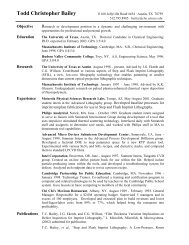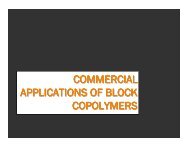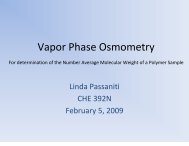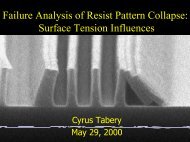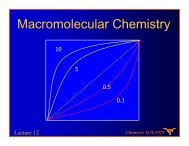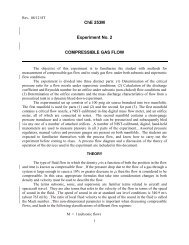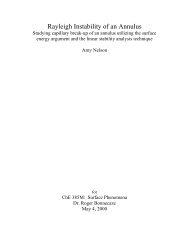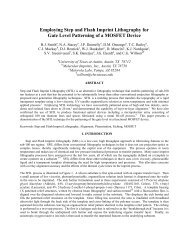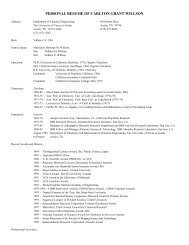Asymmetric fluid-structure dynamics in nanoscale imprint lithography
Asymmetric fluid-structure dynamics in nanoscale imprint lithography
Asymmetric fluid-structure dynamics in nanoscale imprint lithography
- No tags were found...
You also want an ePaper? Increase the reach of your titles
YUMPU automatically turns print PDFs into web optimized ePapers that Google loves.
Chapter 4: Real-Time Gap Sens<strong>in</strong>g Via Fast Fourier Transformsof Spectral ReflectivityAs part of an active stage system, a feedback control system is required toaccurately align the template and the wafer substrate. Several techniques wereconsidered to obta<strong>in</strong> real-time gap <strong>in</strong>formation at several locations between thetemplate and wafer. Based on specific design requirements, FFT-based spectralreflectometry is relatively low-cost method that promises to deliver real-time gapsens<strong>in</strong>g for SFIL.4.1 INTRODUCTIONIn the multi-impr<strong>in</strong>t stepper, the template calibration stages can align thetemplate and wafer to with<strong>in</strong> a s<strong>in</strong>gle <strong>in</strong>terference fr<strong>in</strong>ge across a one-<strong>in</strong>chtemplate. However, the <strong>in</strong>itial orientation of the template may becomemisaligned beyond the calibration specifications due to excessive forces, hardcontact with the wafer, etc. Correction requires that the template be removed andthe calibration to be repeated. A real-time gap sens<strong>in</strong>g method implemented <strong>in</strong>an active stage system will help to solve the issues of calibration, base layerthickness, and wedged base layers. Dur<strong>in</strong>g the squeez<strong>in</strong>g process, an <strong>in</strong> situspectral reflectometry technique based on Fast Fourier Transform (FFT) analysiswill provide the necessary gap and orientation <strong>in</strong>formation. Orientation<strong>in</strong>formation is obta<strong>in</strong>ed <strong>in</strong> the form of gap <strong>in</strong>formation between two flats at threepo<strong>in</strong>ts.Other optical methods to measure film thickness have been proposedwhich employ spectral or Fourier analysis of the reflectivity data from th<strong>in</strong> films.[Bould<strong>in</strong> et al 2000], [Chalmers 2001], [Chason 2000], and [Sakurai and Iida1992]. However, these methods are either not commercially available or not52



